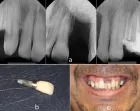Table of Contents
Endocrine abnormalities in two siblings with Rothmund Thomson Syndrome
Published on: 11th October, 2018
OCLC Number/Unique Identifier: 7906107605
Rothmund-Thomson syndrome is a rare autosomal recessive disorder characterized by poikiloderma (skin atrophy, telangiectasia, hyper- and hypopigmentation), congenital skeletal abnormalities, short stature, premature aging, and increased risk of malignant disease. Two siblings with Rothmund-Thomson Syndrome showed the following characteristic features: severe growth failure, dystrophic nails, absent eyelashes/eyebrows, small hands, clinodactyly, microdontia and congential poikiloderma. In addition, delayed sexual development with cryptorchidism in the male and Hashimato thyroiditis in the female patient were detected. These cases are presented here because of these endocrine patterns, with the aim of drawing attention to the invisible aspects of Rothmund-Thomson syndrome.
Comparison of Efficacy and Safety of Hydroxychloroquine and Teneligliptin in Type 2 Diabetes Patients who are Inadequately Controlled with Glimepiride, Metformin and Insulin therapy: A Randomized Controlled Trial with Parallel Group Design
Published on: 13th September, 2018
OCLC Number/Unique Identifier: 7856189396
Aim: The aim of the present study is to assess the efficacy and safety of Hydroxychloroquine in comparison with Teneligliptin in type 2 diabetes patients whose blood glucose levels were inadequately controlled with metformin, Glimepiride and insulin therapy.
Methods: This was a randomized, prospective, parallel-group, experimental trial done in 300 Type 2 Diabetes patients who were uncontrolled (HbA1c=7.5–10%) with metformin, Glimepiride and insulin therapy. Patients were randomly divided into two groups one received Teneligliptin 20 mg (n=152) and other received Hydroxychloroquine 400 mg (n=148) while continuing insulin therapy with other 2 OHA. Insulin doses were adjusted to maintain normal blood glucose levels.
Result: The adjusted mean change from baseline to endpoint in HbA1c was −1.2±0.5% in patient group receiving Hydroxychloroquine and −0.9±0.5% in patients group receiving Teneligliptin, respectively, with a significant between-treatment difference (p<0.001). The incidence of adverse events was similar in the Hydroxychloroquine (72%) and Teneligliptin (77%) groups. However, hypoglycaemic events were less common (p<0.001) and less severe (p<0.05) in patients receiving Hydroxychloroquine than in those receiving Teneligliptin.
Conclusion: Hydroxychloroquine decreases HbA1c in patients whose type 2 diabetes is poorly controlled with high doses of insulin as compare to Teneligliptin. Addition of hydroxychloroquine to insulin therapy is also associated with reduced incidence of confirmed and severe hypoglycaemia.
A Pancreatic Neuroendocrine Tumor with an Unusual Flush
Published on: 14th August, 2018
OCLC Number/Unique Identifier: 7844643436
A 60-year-old man presented with an unusual history of lower limb flushing. A CT scan suggested a pancreatic neuroendocrine tumor. After a robotic distal pancreatectomy, his symptoms completely resolved. The tumor was positive for synaptophysin and chromogranin. This case emphasizes the importance of recognizing atypical features in patients, especially with an unusual skin presentation that might indicate rare tumor types.
Exercise preserves pancreatic β-cell mass and function in obese OLETF rats
Published on: 19th June, 2018
Although exercise has been proposed to be beneficial to type 2 diabetes, its effects on β-cell function and mass remain unclear. In the present study, the effects of long-term swimming training on the function and mass of β-cells in diabetic OLETF rats were examined. At 44 weeks of age after developing diabetes, the OLETF rats were divided into two groups: a control group and an exercise group. The exercise group had a daily swimming for 12 weeks. While not found with the control rats, in the obese OLETF rats, the exercise reduced the weight gain which was associated with improved glucose tolerance and elevated circulating insulin levels as determined by the oral glucose tolerance test and insulin ELISA. The exercise improved plasma total cholesterol and triglyceride levels, and also significantly increased the islet β-cell mass and pancreatic insulin content associated with decreased β-cell apoptosis and elevated activation of the serine/threonine kinase, Akt. The present studies suggest that exercise improves diabetes symptoms via enhancement of the β-cell mass and function through decreasing glucolipotoxicity and reducing β-cell apoptosis by activating Akt in obese OLETF rats.
New pharmacological strategies in some metabolic endocrine disorder under a toxicological approach
Published on: 9th March, 2018
OCLC Number/Unique Identifier: 7666353489
In this review After Observing biomedical literature (starting from some heart disease) results that some pathological phenomena are deeply involved in some metabolic endocrine condition: Kinetics and gradients in metabolism, catabolism, time related, toxic like effect, electrical cell membrane status, smooth vascular muscle cell hyper-reactivity, platelet iperactivations, central autonomic control after acute stroke, great electrolytes unbalances et other factors as pro-hypertrophic signaling and oxidative stress. Observing actual current therapy in some metabolic endocrine therapy often is used association of drugs (in example in type II diabetes). In Many other pathologies efficacy drug therapy exist, and often only 1 pharmacological molecule resolve the pathological condition. But in many disease even associating 2-3-4 drugs the % of cure not increase (efficacy, effectiveness). It mean that this drugs strategies are not the really best? Or it mean a low active level? Why for this pathological condition this association drugs in currently use not do the right works as really needed? There is the need for new really efficacy drugs strategy that show a profile of efficacy as requested in order to resolve the pathological condition? Or to be added to the actual therapy? The actual pharmacological strategies in some metabolic endocrine disorder is really the best? Or other strategies can be introduced?
Indian spices and Caffeine treatment for Obesity and Cardiovascular disease
Published on: 31st January, 2018
OCLC Number/Unique Identifier: 7355979500
The global obesity epidemic that was previously reported [1,2] is now to worsen with obesity to double in 73 countries around the world [3,4]. Improving the health of obese individuals by dietary restriction, anti-obese foods and increased physical activity [1] has not reduced the global obesity epidemic. Obesity is linked to nonalcoholic fatty liver disease (NAFLD) [5,6] with complications relevant to the metabolic syndrome and cardiovascular disease [7]. Appetite control has become critical to endocrinology and metabolism with the apelinergic pathway and nuclear receptor Sirtuin 1 (Sirt 1) now connected to the endocrine system [8] and critical to metabolism. The apelin-Sirt 1 interaction involves nitric oxide (NO) [9] that is now considered as the defect [10] in the interaction between the peptide apelin and calorie sensitive gene Sirt 1 involved in NO imbalances in the adipose tissue, liver and the brain.
Diabetes and red blood cell parameters
Published on: 8th January, 2018
OCLC Number/Unique Identifier: 7355942733
Type 2 diabetes is a common disease in these days and day by day it is arising. The main focus of the study was to investigate association of packed cell volume (PCV), Mean Corpuscular Volume (MPV), Mean Corpuscular Hemoglobin Concentration (MCHC), Red Cell Distribution Width (RDW) with glycemic marker HbA1c. So that PCV, MPV, MCHC, RDW could be used as a predictor of glucoregulation in type 2 diabetes instead of HbA1c value. This study included 87 DMT2 patients, which divided into two groups, A (n=41, presence in diabetics≤6.5-6.9%) and B (n=46, target in diabetes≥7.0%), according to HbA1c values. Spearsman correlation co-efficients were calculated to evaluate the relationship between RBC count, MCHC, RDW with random blood sugar (RBS) and PCV, MCV, MCHC with HbA1c value. Binominal logistic regression analysis was performed to estimate the relationship between glycemic control, as dichotomous outcome of MCHC, RDW, PCV, and MCV as the main prognosticator. MCHC and RDW were significantly higher in the group B compared to the group A. RDW and MCHC may be applied as the auxiliary indicators of deterioration of glucoregulation.

If you are already a member of our network and need to keep track of any developments regarding a question you have already submitted, click "take me to my Query."















































































































































